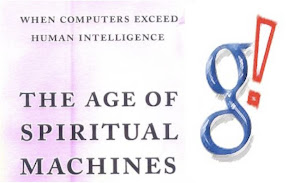
Knowledge and information are the most valuable and sought after commodities for survival. The Google multi-computer brain has mined human knowledge more than any other aggregate entity. All humans seeking to maintain or achieve economic status above peasant-class must be capable of using this all-information tool on a daily basis.
A virtuous civic community featuring a strong associational life is an impediment and harbinger of collective ruin if the members cannot retrieve or post new information online. Association with other humans is still essential for survival, and added to this is association with the world wide web, via its current interface, http://www.Google.com.
The Google multi-computer brain has access to the world wide web mutli-computer brain. The Google machines have gone through several generations.
- Early Stanford Years: 1998
- Sun Ultra II with dual 200 MHz processors, and 256MB of RAM. This was the main machine for the original Backrub system.
- 2 x 300 MHz Dual Pentium II Servers donated by Intel, they included 512MB of RAM and 9 x 9GB hard drives between the two. It was on these that the main search ran.
- F50 IBM RS/6000 donated by IBM, included 4 processors, 512MB of memory and 8 x 9GB hard drives.
- Two additional boxes included 3 x 9GB hard drives and 6 x 4GB hard drives respectively (the original storage for Backrub). These were attached to the Sun Ultra II.
- IBM disk expansion box with another 8 x 9GB hard drives donated by IBM.
- Homemade disk box which contained 10 x 9GB SCSI hard drives.
- Current hardware: 2000-2007
- Servers are commodity-class x86 PCs running customized versions of Linux. Indeed, the goal is to purchase CPU generations that offer the best performance per unit of power, not absolute performance.
- Over 450,000 servers[1] ranging from a 533 MHz Intel Celeron to a dual 1.4 GHz Intel Pentium III (as of 2005)
- One or more 80GB hard disks per server (2003)
- 2–4 GiB of memory per machine (2004)
- Code name: Project 02: 2007-Future
- Google is currently developing a supercomputer at a data center located in the town of The Dalles, Oregon. The new complex is approximately the size of two football fields with cooling towers four stories high.
These have been formative stages of the Google brain. Amongst the world's non-miserable class -a class definable as those with access to global information to inform or empower their mobility, this brain is the most essential ingredient in their classification away from oppression or death. For social justice or political empowerment to occur, some portion of it must have been in the form of a query to the top-tier reference to the world wide web.
This Giant Cyborg Aggregate of All Human Knowledge is uniquely powerful, but not in the same way as power was manifest in early-middle industrial times. This new kind of "Most Powerful" has a core function of dispensing knowledge, which is antithetical to hoarding it within a veil of secrecy.
Oddly enough, this Giant Cyborg Aggregate of All Human Knowledge grants interviews with questions about its presumably secret inner life, and the interviews are granted 24/7 to anyone online.
Interview with Google.com
Question: We have a heard there is a Google Owners Manual. Answer: Question: Tell us more about the secretive Project 02 in The Dalles, Oregon. Answer: Photos: Question: Have you ever been hacked? Answer: Question: This Goolge-Super-AI-Cyborg-Ruling-the-World-Benevolently-Thing, are there others writing about you in this way? Answer:Google speaks to the world in other ways besides a propositional query. The humans in the "company/corporation" sponsor and video record lectures that "do not represent the views of Google Inc" but nonetheless propagate memes via sight and sound. They are called googletechtalks. One lecture connects nicely with the concept of Google as a giant AI. It is titled "Polyworld: Using Evolution to Design Artificial Intelligence", at http://www.youtube.com/watch?v=_m97_kL4ox0.
Supporting and supplemental documents:

http://infolab.stanford.edu/~backrub/google.html
http://citeseer.ist.psu.edu/brin98anatomy.html



No comments:
Post a Comment